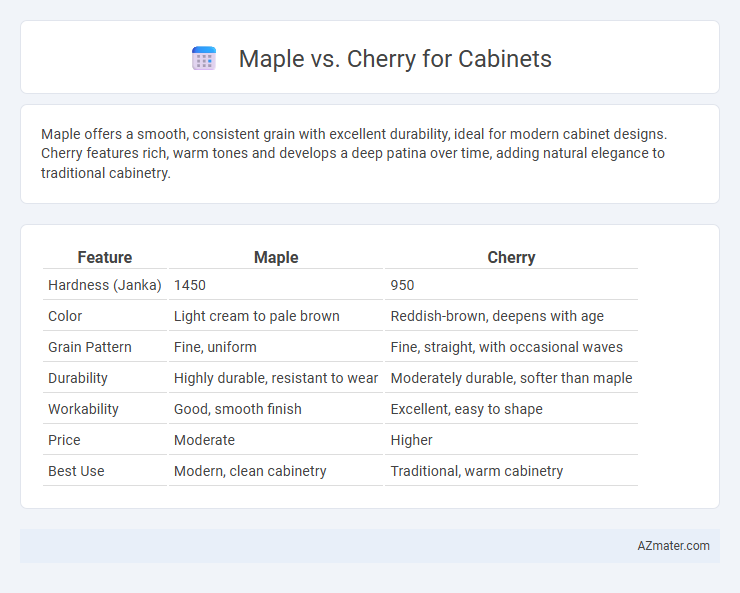Maple offers a smooth, consistent grain with excellent durability, ideal for modern cabinet designs. Cherry features rich, warm tones and develops a deep patina over time, adding natural elegance to traditional cabinetry.
Table of Comparison
| Feature | Maple | Cherry |
|---|---|---|
| Hardness (Janka) | 1450 | 950 |
| Color | Light cream to pale brown | Reddish-brown, deepens with age |
| Grain Pattern | Fine, uniform | Fine, straight, with occasional waves |
| Durability | Highly durable, resistant to wear | Moderately durable, softer than maple |
| Workability | Good, smooth finish | Excellent, easy to shape |
| Price | Moderate | Higher |
| Best Use | Modern, clean cabinetry | Traditional, warm cabinetry |
Maple vs Cherry: Introduction to Cabinet Wood Choices
Maple offers a smooth, light-colored finish with exceptional hardness and resistance to dents, making it a popular choice for cabinets requiring durability and a clean aesthetic. Cherry wood, known for its rich reddish-brown hue and fine grain, darkens gracefully over time, adding warmth and elegance to cabinetry. Both woods excel in strength and workability, but maple is preferred for a modern look, while cherry suits traditional or classic kitchen designs.
Key Characteristics of Maple Cabinets
Maple cabinets are renowned for their smooth grain and light, creamy color, which allows for versatile staining and finishing options. They offer exceptional durability and resistance to dents and scratches, making them ideal for high-traffic kitchen areas. Compared to cherry, maple provides a more uniform appearance and maintains its color stability better over time, making it a popular choice for contemporary cabinetry.
Key Characteristics of Cherry Cabinets
Cherry cabinets are prized for their rich, warm reddish-brown hue that deepens and darkens with age, offering a timeless elegance in kitchen design. Their fine, straight grain coupled with a smooth texture enhances the visual appeal while providing excellent durability and resistance to warping. This hardwood's natural ability to withstand dents and scratches makes cherry a preferred choice for high-quality, long-lasting cabinetry.
Color and Appearance Differences
Maple cabinets feature a light, creamy color with subtle grain patterns that create a smooth, uniform appearance ideal for modern and minimalist designs. Cherry wood exhibits a rich, warm reddish-brown hue that darkens with age, offering a classic and elegant look enhanced by its distinctive, fine grain. The color stability of maple makes it less prone to noticeable changes over time compared to cherry, which develops a deeper patina, adding character to cabinetry.
Durability and Hardness Comparison
Maple offers exceptional durability and hardness, ranking around 1450 on the Janka hardness scale, making it resistant to dents and scratches in cabinet applications. Cherry wood, with a Janka hardness of approximately 950, is softer but provides a smooth surface that ages beautifully, developing a rich patina over time. While maple withstands heavy daily use better due to its superior hardness, cherry's moderate durability balances elegance with functional resilience in cabinetry.
Grain Patterns: Maple vs Cherry
Maple cabinets feature a fine, uniform grain pattern that offers a smooth, consistent surface ideal for modern, sleek kitchen designs. Cherry wood displays a more pronounced, flowing grain with rich variations and occasional natural blemishes, adding warmth and character to traditional or rustic cabinetry. The distinct grain visibility in cherry enhances its natural beauty, while maple's subtle pattern provides a versatile, clean look.
Cost and Affordability Analysis
Maple cabinets typically cost between $150 and $250 per linear foot, offering a mid-range price point that balances durability and aesthetic appeal, while cherry cabinets range from $250 to $500 per linear foot, reflecting their higher quality and rich color over time. The affordability of maple makes it a popular choice for homeowners seeking a stylish yet budget-friendly option, whereas cherry's higher initial investment is often justified by its long-term value and classic appearance. Comparing costs reveals that maple provides a cost-effective solution for quality cabinetry, while cherry suits those prioritizing luxury and longevity despite a premium price.
Suitability for Different Kitchen Styles
Maple cabinets offer a smooth, fine grain and light color that suits traditional, modern farmhouse, and contemporary kitchen styles by providing a clean and versatile backdrop. Cherry cabinets, with their rich reddish-brown hue and pronounced grain, complement classic, rustic, and elegant kitchen designs, adding warmth and depth to the space. Both woods provide durable options but differ in aesthetic impact, making maple ideal for brighter, airy kitchens and cherry perfect for cozy, sophisticated environments.
Maintenance and Longevity
Maple cabinets are renowned for their hardness and resistance to dents and scratches, requiring minimal maintenance and lasting several decades with proper care. Cherry wood, while slightly softer than maple, develops a rich patina over time, enhancing its aesthetic appeal but necessitates occasional refinishing to maintain its smooth surface and prevent wear. Both woods offer excellent longevity, but maple's durability makes it a preferred choice for kitchens with high traffic and frequent use.
Final Verdict: Choosing Between Maple and Cherry
Maple offers a light, smooth grain with exceptional hardness, making it resistant to dents and ideal for a modern, durable cabinet finish. Cherry features a rich, warm reddish tone that deepens with age, valued for traditional and elegant cabinetry styles. The final choice between maple and cherry hinges on whether durability and a lighter aesthetic or warmth and natural color aging better suit your kitchen design priorities.

Infographic: Maple vs Cherry for Cabinet
 azmater.com
azmater.com